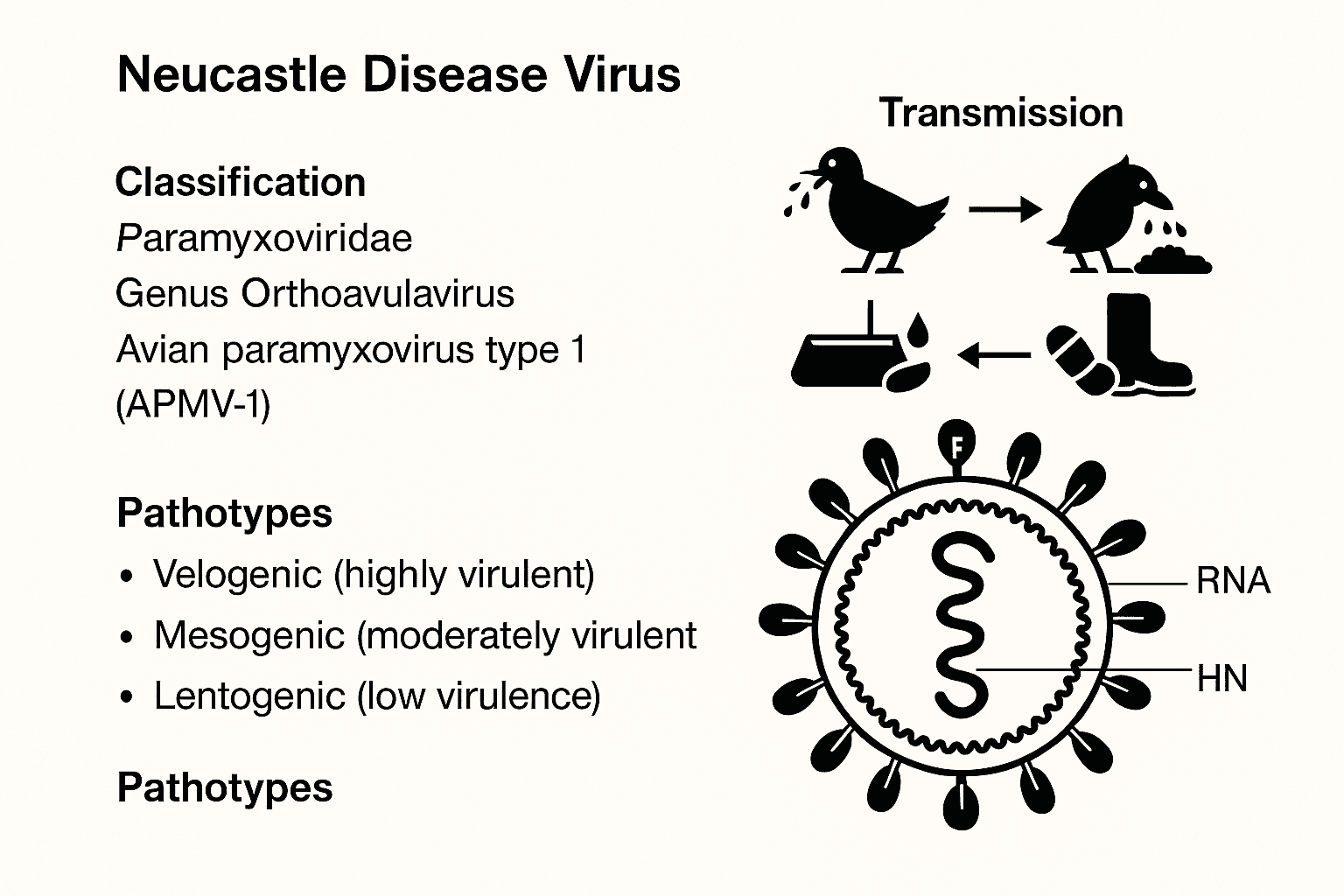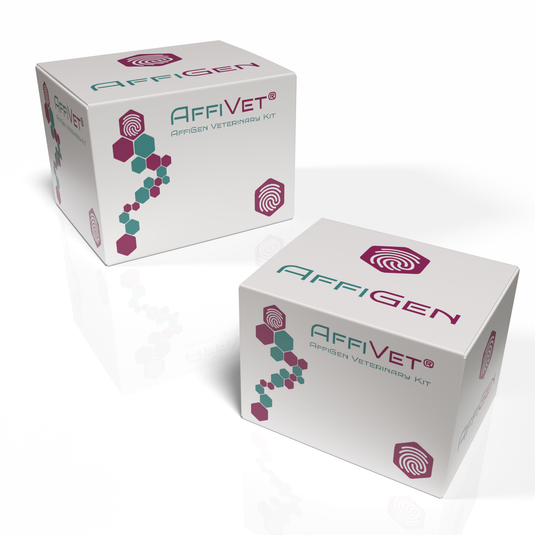Newcastle Disease Virus (NDV) is a globally distributed, avian paramyxovirus that causes serious outbreaks in poultry populations. This RNA virus poses a major challenge to bird farms, aviaries, and hatcheries, especially in areas where biosecurity and vaccination programs are inconsistent. The infection is caused by strains of Avian Paramyxovirus serotype 1 (APMV-1) and varies in severity based on the genotype, host species, and immune status of the birds.
Viral Classification and Genomics
NDV is classified in the genus Orthoavulavirus, family Paramyxoviridae, and order Mononegavirales. The complete genome of NDV ranges from 15,186 to 15,198 nucleotides, depending on the strain (NCBI Genome). The genome encodes six structural proteins:
-
NP (nucleocapsid)
-
P (phosphoprotein)
-
M (matrix protein)
-
F (fusion protein)
-
HN (hemagglutinin-neuraminidase)
-
L (large polymerase)
The F protein cleavage site is a key determinant of pathogenicity. Virulent strains possess multiple basic amino acids at this site, allowing cleavage by host proteases and systemic viral spread (Cornell University Avian Diagnostic Lab).
Pathotypes of NDV
NDV strains are traditionally grouped into three main pathotypes based on clinical signs and mortality in chickens:
-
Velogenic: Highly virulent, causes neurological, respiratory, and gastrointestinal signs. Often leads to rapid mortality.
-
Mesogenic: Intermediate virulence, moderate respiratory and nervous symptoms.
-
Lentogenic: Low virulence; typically used in live-attenuated vaccines (Merck Veterinary Manual).
These classifications are validated through biological tests such as the intracerebral pathogenicity index (ICPI) and mean death time (MDT) in embryonated eggs (FAO ND Manual).
Natural Host Range and Viral Shedding
NDV infects over 250 bird species, both domestic and wild. Chickens are the most susceptible, but the virus also affects turkeys, pigeons, pheasants, ducks, geese, and wild birds such as cormorants and double-crested terns. Infected birds shed virus through:
-
Feces
-
Nasal discharges
-
Feather dander
-
Contaminated surfaces (feeders, water lines, cages)
Viral shedding begins approximately 2–5 days post-infection and can persist for several weeks depending on the species and strain (USGS National Wildlife Health Center).
Transmission Mechanisms
NDV spreads via:
-
Direct bird-to-bird contact
-
Fomites (shoes, vehicles, tools, feed)
-
Aerosol transmission
-
Vertical transmission (rare and poorly documented)
Long-distance spread can also occur via migratory birds and improperly cleaned shipping containers for live poultry. The virus is environmentally stable, particularly in organic matter and low temperatures (USDA Biosecurity Guide).
Molecular Detection and Surveillance
Accurate detection of NDV is crucial for control and containment. Common molecular methods include:
-
Real-time RT-PCR: Targets the fusion gene for rapid identification (CDC Protocols)
-
Virus isolation: Using SPF embryonated eggs
-
Hemagglutination inhibition (HI) assay
-
Next-generation sequencing: For genomic surveillance and variant tracking (NCBI Virus).
Surveillance efforts are supported by programs like the National Animal Health Laboratory Network (NAHLN) and National Poultry Improvement Plan (NPIP).
Vaccine Development and Deployment
Vaccination remains the most effective method to prevent NDV outbreaks. Current vaccines include:
-
Live attenuated vaccines (LaSota, B1)
-
Inactivated oil-emulsion vaccines
-
Recombinant vector vaccines (e.g., fowlpox-NDV hybrids)
Live vaccines are administered via:
-
Aerosol spray
-
Drinking water
-
Eye or nasal drops
Research continues on subunit vaccines, DNA-based constructs, and plant-expressed antigens for cost-effective, scalable solutions (ARS USDA Vaccine Research).
Environmental and Management Strategies
NDV outbreaks can devastate entire bird populations if biosecurity protocols are not strictly followed. Key measures include:
-
Isolating new flocks
-
Quarantine of sick or exposed birds
-
Controlled movement of personnel
-
Disinfection of equipment and facilities
-
Use of NDV-free feed and bedding materials
The Biosecurity for Birds campaign by USDA provides free resources and posters to raise awareness among poultry caretakers (Biosecurity Portal).
Global Epidemiology and Wild Bird Surveillance
NDV is endemic in many parts of Africa, Asia, and Latin America. In North America and Europe, outbreaks are sporadic but still pose a high risk due to trade and wildlife interactions. The World Organisation for Animal Health (WOAH) classifies it as a disease of global concern due to potential transboundary spread (WOAH Disease Card).
Migratory bird monitoring is coordinated by groups like Bird Banding Laboratory (USGS) and USDA Wildlife Services.
Research Trends and Technological Innovations
NDV research has expanded to include:
-
Genomic plasticity and recombination
-
CRISPR-based viral gene editing
-
Reverse genetics systems to create attenuated strains
-
Mucosal immunity pathways in birds
-
Environmental virus survival modeling
Key research centers include:
Conclusion
Newcastle Disease Virus remains a persistent challenge for avian populations across the world. Scientific collaboration, surveillance, and targeted vaccination strategies are crucial to mitigate its impact. By understanding NDV at the molecular, ecological, and epidemiological levels, better prevention methods can be developed and implemented at both commercial and community levels


